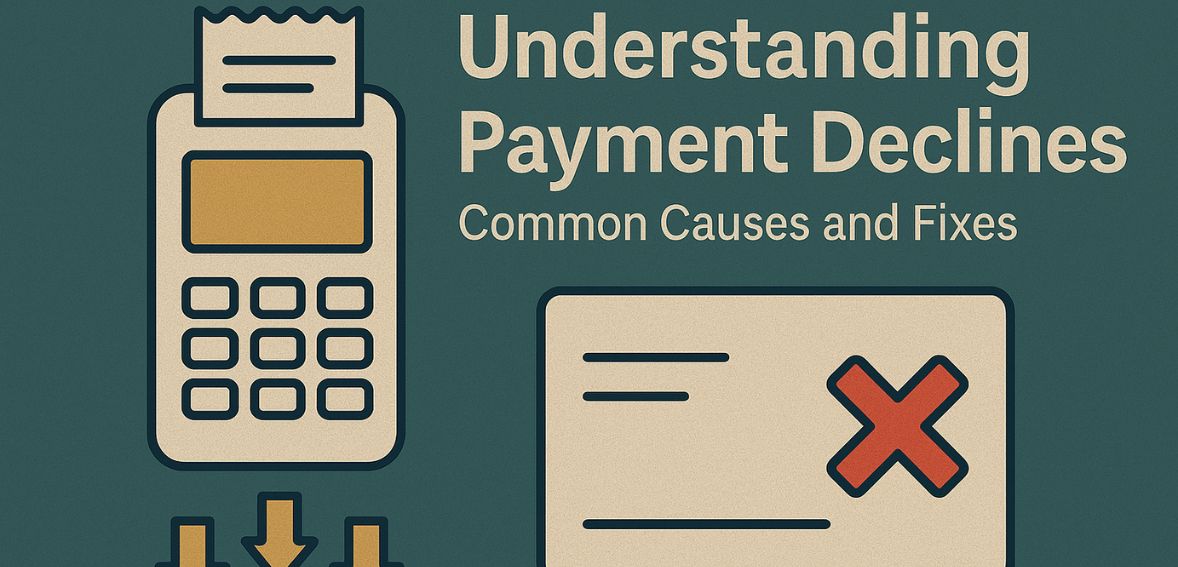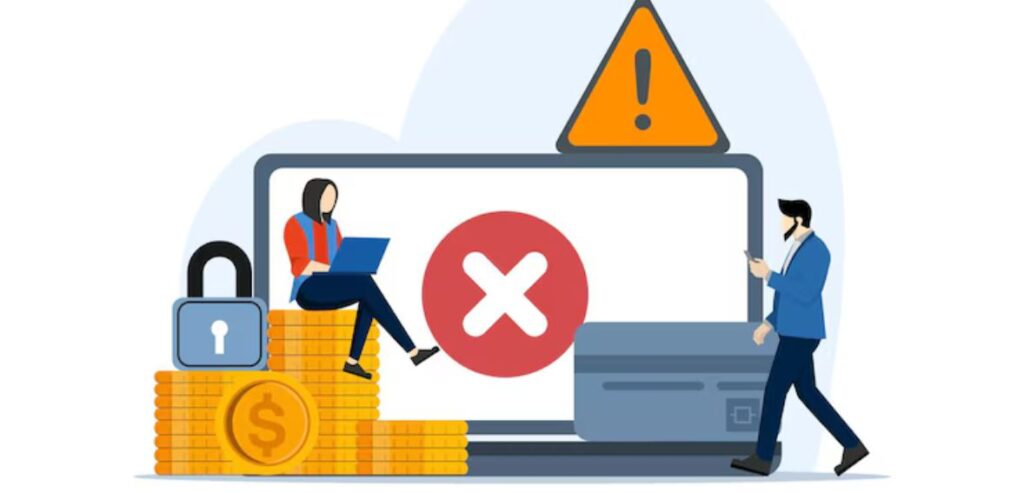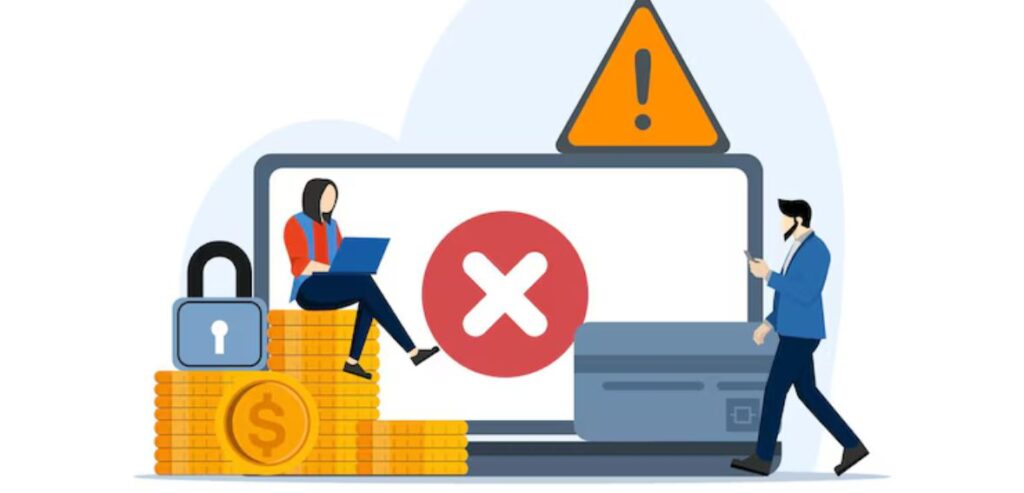
By Cole Knightley July 14, 2025
With mobile wallets, one-click checkouts, and auto-renewing subscriptions now the norm, customers expect their payments to go through without a hitch. Payment declines, however, remain a frustrating and surprisingly common reality for both customers and businesses, even in this highly digital age. A declined payment—whether for a daily purchase or a high-ticket item—can instantly lead to confusion, embarrassment, or even a lost sale.
For entrepreneurs, particularly those who operate subscription services or e-commerce platforms, the pain of a failed transaction goes beyond a brief annoyance. It may result in lost sales, hampered consumer experiences, and eroded brand confidence. Customers may find the disruption, which frequently lacks context or a clear resolution, to be personal.
To minimize disruptions and improve approval rates, it’s essential to first understand why payments get declined in the first place. Although many people believe that a payment failure is caused by a straightforward mistake, such as insufficient funds, the reality is more complex. Numerous technical, financial, behavioral, and regulatory factors are involved, some of which are totally uncontrollable by the customer or merchant. However, that does not imply that they cannot be fixed.
By separating the preventable from the unavoidable, this article investigates the true causes of payment declines. Additionally, it outlines tactics that merchants can use to lower decline rates, enhance communication, and easily recover unsuccessful payments. Knowing the fundamental causes of payment failures will benefit you whether you run a small business, a large corporation, or are just an inquisitive customer.
The Hidden Complexity Behind a Declined Payment

A payment decline is an unavoidable occurrence for any company that takes digital or card payments. Declined payments, whether they occur during a customer’s in-store checkout or when they attempt to pay online, cause confusion, embarrassment, or even lost sales. Refused transactions can be discouraging and frustrating for customers. For retailers, it can indicate more serious issues with the customer’s financial provider, security procedures, or payment infrastructure than just a lost sale.
Soft vs. Hard Declines: Knowing the Difference
At first glance, payment declines might appear simple—a card either works or it doesn’t. However, the truth is much more nuanced. Every payment attempt is processed behind the scenes by a number of networks, systems, banks, and fraud detection algorithms. The entire transaction may be blocked if even one link in this chain malfunctions or raises an alarm.
Payment rejections generally fall into two types: soft declines and hard declines. A soft decline is a transient problem that might go away if the card is tried again or used in a different way. These may include issues like network failures, session timeouts that have expired, or the requirement for additional validation. A hard decline, on the other hand, signals a permanent issue that requires the customer to use a different payment method or contact their bank. These can be triggered by factors such as closed accounts, reported fraud, or invalid card details.
Insufficient Funds: The Most Common Culprit

Lack of funds is one of the most frequent reasons why payments are refused. The problem is simple: there isn’t enough money in the card’s linked account to cover the transaction. This is especially prevalent in retail and subscription-based services. It’s possible that the client isn’t keeping a careful eye on their account or is unaware that an automated withdrawal is planned for the same day. Businesses can lessen the impact of the customer’s available balance issue by providing flexible payment scheduling, retry logic, or payment reminders prior to billing.
Another common cause of unsuccessful transactions is card expiration. Customers often forget to update their card information when their previous one expires. For subscription-based services, where stored credentials are required for recurring payments, this is particularly problematic. By sending email alerts prior to expiration dates, requesting updated information, or integrating with payment platforms that provide automatic account updater services—which retrieve new card credentials from issuing banks—businesses can proactively address this issue.
Fraud Prevention Systems: Balancing Safety and Sales
Fraud prevention systems are another major contributor to payment declines. To identify suspicious activity, banks and card networks employ complex algorithms. A transaction may be flagged and rejected as possibly fraudulent if it differs from the customer’s typical pattern, such as a purchase from a foreign nation, an unusually large amount, or multiple quick transactions.
While this helps prevent fraud, it also increases the risk of false declines—where legitimate transactions are incorrectly rejected. Merchants can collaborate with their payment processor to make sure their fraud prevention settings are balanced to lessen the likelihood that legitimate purchases will be blocked.
While lenient settings can lead to actual fraud, too strict ones can result in false positives and alienate customers. Businesses can establish a more secure yet smooth payment environment by utilizing adaptive fraud filters, real-time verification, and machine learning tools.
Mismatched Billing Details and Input Errors

Inaccurate billing details are another overlooked reason behind many payment rejections. Customers must enter information such as their ZIP code, card verification value (CVV), and billing address when making card-not-present transactions, like those done online. The transaction might be denied if any of these details are entered inaccurately or don’t match what the bank has on file.
Although these reductions are intended to deter card theft, they may also deceive law-abiding consumers. In order to minimize errors, merchants can assist by designing their checkout pages to clearly explain what is required, auto-filling known details when feasible, and validating inputs in real time.
Technical Issues Between Merchant and Processor
Sometimes, a simple connectivity glitch between a merchant and the payment gateway can derail a transaction. This may occur as a result of network overload, system maintenance, or a payment gateway configuration error. These circumstances, which are frequently out of the merchant’s direct control, can impact several transactions at once. By choosing a trustworthy payment gateway that provides redundancy, failover routing, and consistent uptime, businesses can lessen these issues.
International Transactions and Geolocation Flags
Geopolitical limitations currency mismatches, and regional restrictions can all lead to declines in international transactions. For instance, due to location-based fraud regulations or compliance restrictions, the issuing bank may block a transaction when a customer from one nation tries to make a purchase from a website located in another.
Businesses that want to conduct business internationally must make sure that their payment system is capable of handling international cards, multiple currencies, and regional routing. Providing local payment options, such as digital wallets or platforms tailored to a particular nation, can also increase the success rates of international trade.
Challenges with Recurring Payments and Subscriptions
Another level of complexity is introduced by recurring transactions. Customers may not notice payment declines in subscription models right away, particularly if the product or service has a grace period. Recurring card rejections may result in customer attrition or service outages. Businesses can recover unsuccessful payments more quickly and maintain client relationships by putting dunning management techniques into place, such as intelligent retry schedules, customized follow-up messages, and escalation protocols.
Customer Behavior and Checkout Abandonment

Customer behavior during the checkout process is another area that is often ignored. If a checkout page is slow or looks untrustworthy, customers might rush through it—or abandon it entirely. Additionally, the transaction might be rejected if the user does not reply promptly when a bank or processor requests two-factor authentication.
Even though there was technically no attempt at payment, these drop-offs may be interpreted as payment failures. These incidents can be significantly decreased by enhancing page performance, creating user-friendly checkout processes, and guaranteeing transparency regarding security features.
Merchant-Side Restrictions and Configuration Errors
Transactions may occasionally be refused due to merchant-side limitations. This covers situations in which the merchant account is set up to deny specific card kinds, transaction amounts, or geographical areas. These settings can unintentionally turn away legitimate business, even though they are frequently implemented to reduce risk or control fees. The merchant environment can be made more in line with customer needs and expansion objectives by conducting regular reviews of processor settings, payment policies, and risk parameters.
Communication: The Customer Experience Factor
It’s important to consider both sides of the transaction when handling payment declines. Customers may find a declined payment to be inconvenient or embarrassing. Even if the bank or payment provider was the source of the problem, a poorly managed situation may result in a bad impression of the company. Transparency and communication are therefore essential. Trust can be preserved by giving customers clear error messages, providing alternate payment methods, and assuring them that their security is a top concern.
Proactive Monitoring and Root Cause Analysis
Merchants need to be proactive on the backend. This involves keeping an eye on decline rates, examining error codes, and closely collaborating with their payment service providers to spot trends. It might be worthwhile to look into this further if a particular bank or card brand is causing an oddly high number of declines. Certain platforms provide dashboards that show comprehensive metrics on payment performance, assisting merchants in identifying problems and implementing data-driven fixes.
Smart Retry Logic: Giving Payments a Second Chance
One of the best strategies for recovering from soft declines is to incorporate intelligent retry logic. The system can try again a few minutes or hours later, ideally when the problem might be fixed, instead of giving up on the initial unsuccessful attempt. For instance, a retry might succeed once the customer has added funds to their account or completed a bank verification step. Companies can also create processes that alert clients automatically when a payment fails, telling them to change their payment method or get in touch with their bank.
Tokenization and Card Lifecycle Management

Reducing declines for repeat transactions is largely dependent on tokenization. Businesses can safely store payment credentials and make subsequent billing attempts without reentering information by substituting encrypted tokens for sensitive card information. This expedites the checkout process and lowers the possibility of errors. Transaction success rates can be raised and churn can be further decreased by platforms that provide token lifecycle management, which includes automatically updating reissued or expired cards.
Conclusion
Businesses and customers alike have to understand the reasons behind payment failures. Avoidable problems like expired cards, mismatched billing information, or overly strict fraud filters are frequently the cause of these declines. Businesses can increase customer satisfaction and recover lost revenue by determining the underlying causes and making necessary process adjustments.
As online payments grow more complex, taking proactive steps like refining fraud settings, updating payment options, and using smart routing becomes vital. A seamless payment process fosters trust, and dealing directly with declines guarantees fewer interruptions and more solid connections with each transaction.